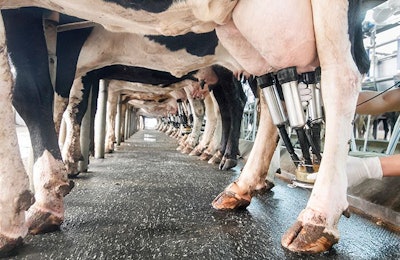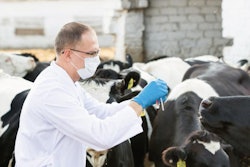
Rabobank expects slight increase in milk production and export demand challenges
Global dairy demand is beginning to recover from the jolt it experienced at the beginning of the novel coronavirus (COVID-19) pandemic, but uncertainty and volatility remain high.
In its global dairy update for the second quarter of 2020, Rabobank said demand recovery has been jump-started by government intervention through dairy purchases, direct payments and storage aid, along with the reopening of many foodservice establishments.
“Lockdowns are being lifted, foodservice pipelines are refilling, governments are intervening, and volatility abounds,” Rabobank said in the report. “But, while price rebounds are welcome, it may be best to wait for the dust to settle to assess the true strength of the current market.”
Rabobank’s outlook assumes there will not be a major resurgence of COVID-19, but it adds that the possibility cannot be ruled out, adding to the uncertainty about the future.
“The balance between foodservice sales and retail sales has been one of the most defining features of this crisis,” it said. “Foodservice sales will take time to return to normal due to remaining capacity restrictions and cautious consumers,” while “retail sales will eventually return to a normal trend over time.”
As much of the world emerges from lockdowns into economic recession, exchange rates will add to the export demand challenges for producers.
“Heavy inventories and reduced demand growth will weigh on global milk prices through 2020 and into 2021,” the report said. “In much of the world, dry weather is also impacting feed availability and cost, which is pressuring margins on dairy farms.”
Rabobank still expects a slight increase in production across the major milk-producing regions – EU, U.S., New Zealand, Australia, Brazil, Argentina, India and China.
“Southeast Asia has been a critical force in driving import demand opportunities for exports from many milk-producing areas. With an expected demand reduction coming from this region, and lower Chinese import needs, there could be a surplus of milk, contributing to high stock levels in the second half of 2020.”
Some regional highlights from the report:
European Union
- EU milk deliveries in the first quarter of 2020 were 1.4% higher than last year at 544,000 metric tons
- The third consecutive dry season is underway in Northern and Western Europe, affecting grass growth and crop development.
- Rabobank has revised its previous 2020 EU milk production forecast growth from 0.7% to 0.6% year over year in the second quarter, and it revised its milk production growth forecast for the second half from 0.6% to 0.5%.
- Domestic consumption is expected to be down 3% year over year in the second quarter due to foodservice volume losses, and is expected to be down 1% in the third quarter.
United States
- U.S. April milk production was up 1.4% year over year, but “it’s likely that the actual amount of milk delivered to plants was much lower than this, only increasing by less than 0.5% once you subtract milk that was dumped on-farm, fed to calves, mixed into rations or otherwise disposed of before being processed.”
- Rabobank expects milk production to increase by 0.9% in the second half before moving toward a more normal 1.5% year-over-year growth rate by the second quarter of 2021.
- U.S. total dairy demand increased 0.2% year over year in the first quarter of 2020.
- Rabobank has revised its 2020 U.S. demand forecast to a decrease of 0.8% year over year in the second half of 2020 and a decrease of 2% for the full year.
- In the U.S., milk producers are experiencing rapidly varying price signals and an unfamiliar magnitude of volatility.
New Zealand
- Parts of New Zealand are experiencing their driest period on record, slowing pasture growth and, subsequently, milk production, and also increasing the use of purchased feed.
- Rabobank forecasts total milk production in New Zealand to expand 1.8% in the 2020-21 season.
Australia
- Milk production in Australia was up 6.7% in April year over year, but season-to-date milk production is down 1.6% year over year.
- Wetter-than-average conditions are forecast for June to August, leading farmers to begin rebuilding stocks.
Brazil
- High feed costs are a challenge for dairy farmers in Brazil.
- Milk production is expected to fall by 1.8% during the first half of 2020.
Argentina
- Rabobank estimates Argentina’s milk production will rise by 8% in the first half of 2020.
- Argentina’s dairy farmers saw a profitable first quarter thanks to government measures to increase export taxes on grains that reduced domestic prices of corn and soybean meal, but profitability is expected to near zero by July.
- Higher milk production coming at the same time as weakening local demand and a less competitive export market will challenge the country’s dairy producers.
India
- Demand for milk and dairy products in India has remained high, and the country’s milk production in the first quarter of 2020 was higher than in the same period in 2019.
- Farmgate milk prices have decreased by more than 25%.
China
- China’s dairy imports are forecast to drop 15% year over year in 2020.
- Rabobank estimates that China’s dairy demand in the first half 2020 will fall by 7%, normalize in the second half and grow by 1.5% year over year.
- Full-year dairy consumption is forecast to decline 2.7% year over year.
- Milk production is forecast to increase by 4.3% year over year in the first half of 2020 and 2% in the second half.
View our continuing coverage of the novel coronavirus (COVID-19) pandemic.











